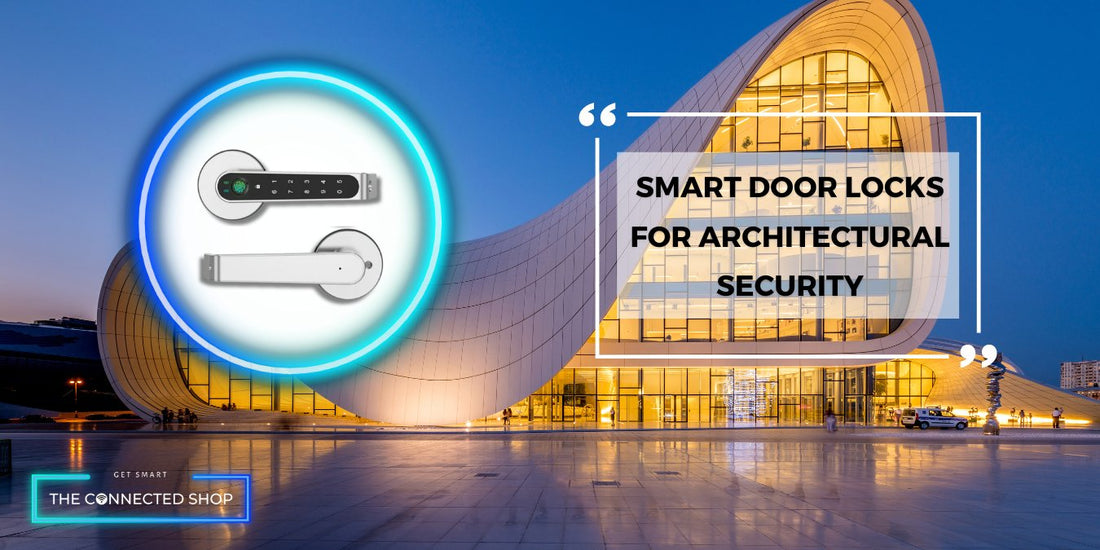In the field of architecture, ensuring the security of a building is as critical as its design. As advancements in technology shape new standards for safety, smart door locks for architecture have become an essential tool for architects looking to enhance security without compromising on design. These sophisticated locking systems not only provide greater control over access but also contribute to a comprehensive approach to building protection.
This post examines the important role that smart door locks play in reinforcing building security, particularly through the lens of architectural practice. We’ll also present a case study on MS Architect, who selected ADA Smart Door Locks to meet both security and accessibility requirements in their latest projects. By integrating smart door locks into your designs, you can achieve a higher level of security that aligns with the demands of modern architecture.
How Smart Door Locks Enhance Building Security
Smart door locks for architecture have upgraded the way buildings are secured, offering a level of control and convenience that traditional locks simply cannot match. By incorporating advanced technology, these locks provide architects with tools to design buildings that are not only secure but also adaptable to modern demands. Here’s a closer look at the key features of smart door locks that contribute to building security and how they compare to traditional locking systems.
Key Features of Smart Door Locks That Contribute to Security
Remote Access Control: Smart door locks allow users to lock or unlock doors remotely via a smartphone app or web interface. This feature is particularly useful for managing access when users are offsite or for granting temporary access to visitors or service providers without needing to be physically present.
Real-Time Monitoring and Alerts: These locks offer real-time monitoring, sending alerts to users when doors are accessed or when an unauthorized attempt is made to gain entry. This immediate feedback allows for prompt action, enhancing the security of the building.
Auto-Locking Mechanisms: Smart door locks can be programmed to automatically lock after a specified period, ensuring that doors are never accidentally left unsecured. This feature is especially beneficial in high-traffic areas or for ensuring security during off-hours.
Biometric Access: Many smart door locks for architecture offer biometric access, such as fingerprint recognition, which adds an extra layer of security by ensuring that only authorized individuals can gain entry.
Integration with Other Security Systems: Smart door locks can often be integrated with broader security systems, including cameras, alarms, and intercoms, creating a comprehensive security network that is centrally controlled and monitored.
Comparison with Traditional Locking Systems
Control and Flexibility: Traditional locks rely on physical keys, which can be lost, copied, or stolen, posing a security risk. In contrast, smart door locks offer digital keys that can be easily managed, reissued, or revoked, providing greater control over access.
Security Features: Traditional locks provide a basic level of security, but they lack the advanced features of smart door locks, such as remote access and real-time monitoring. Smart door locks offer a proactive approach to security, while traditional locks are often reactive, only addressing security concerns after an issue has occurred.
Convenience: Smart door locks eliminate the need for physical keys, reducing the risk of lockouts and making it easier to manage access for multiple users. Traditional locks require physical interaction, which can be inconvenient and time-consuming, particularly in large or busy buildings.
Upgradability: While traditional locks are static in their functionality, smart door locks can often receive software updates, allowing them to evolve with new security protocols and features. This adaptability ensures that smart door locks remain a relevant and effective security solution over time.
By integrating these advanced features, smart door locks for architecture provide a significant enhancement in building security, offering architects the ability to design spaces that are not only secure but also efficient and user-friendly.
Choosing the Right Smart Door Locks for Different Architectural Projects
Selecting the appropriate smart door locks for a building involves more than just choosing a device with the latest features; it requires thoughtful consideration of the building's unique needs, purpose, and design context. From residential complexes to commercial spaces and institutional facilities, each type of building has distinct security requirements that must be addressed to ensure safety and convenience. Here are key factors to consider when choosing smart door locks for various architectural projects and how to tailor these solutions to specific contexts.
Building Type and Usage
Residential Buildings: Prioritize smart door locks that offer a balance of security, ease of use, and convenience. Features like biometric access (fingerprint or facial recognition), remote access control, and integration with home automation systems can enhance both security and user experience.
Commercial Buildings: Focus on smart door locks that provide robust access control and monitoring capabilities. Consider options that support multiple user credentials, have audit trail features, and integrate seamlessly with existing security systems like CCTV and alarm systems.
Institutional Facilities (e.g., hospitals, schools, government buildings): These buildings often have high traffic and strict security requirements. Look for smart door locks for architecture that offer advanced access control features, such as multi-factor authentication, time-sensitive access, and automatic locking. Durability and compliance with safety and accessibility standards (such as ADA requirements) are also crucial.
Access Control Requirements
Consider the level of control needed over who enters and exits the building. For high-security areas, opt for smart door locks that provide detailed access logs, customizable user permissions, and multi-tiered access levels.
For public or semi-public spaces, prioritize smart door locks that can handle frequent usage, provide emergency override options, and are easy to reconfigure as access needs change.
Integration with Existing Systems
Ensure that the chosen smart door lock can integrate with other security and building management systems already in place. Compatibility with systems like video surveillance, alarm systems, or visitor management software can create a more cohesive and comprehensive security solution.
Aesthetic and Architectural Compatibility
The appearance of the smart door locks for architecture should complement the overall design of the building. For modern, minimalist designs, sleek and streamlined smart door locks may be more appropriate, while traditional buildings may require smart door locks with more classic finishes and designs that blend seamlessly with the existing decor.
Durability and Environmental Considerations
For outdoor or high-use areas, choose smart door locks that are weather-resistant, tamper-proof, and built to withstand frequent use. Consider factors like humidity, temperature variations, and potential exposure to harsh environmental conditions when selecting smart door locks.
Compliance and Regulatory Requirements
Ensure that the smart door locks comply with local building codes, fire safety regulations, and accessibility standards. For institutional buildings, this may include ADA compliance or other specific requirements related to the building's function and user base.
Case Study: MS Architect’s Use of ADA Smart Door Locks
MS Architect is a well-established architectural firm known for its innovative designs and commitment to creating spaces that balance functionality with aesthetic appeal. Specializing in both commercial and residential projects, MS Architect consistently seeks out advanced solutions to meet the diverse needs of their clients. In one of their projects last year, the firm needed to ensure that a new commercial building met strict security requirements while also adhering to accessibility standards. To achieve these objectives, MS Architect partnered with The Connected Shop for an effective solution.
Recognizing the importance of combining security with accessibility, MS Architect selected the ADA Smart Door Lock from The Connected Shop. These locks were chosen for their robust security features and full compliance with the Americans with Disabilities Act (ADA) standards. The firm’s decision to invest in ADA Smart Door Locks was motivated by a commitment to inclusivity and ensuring that all users could securely and conveniently access the building.
Integration of ADA Smart Door Locks
The ADA Smart Door Locks were integrated into the project to meet both the security and accessibility needs of the building. They were strategically installed at essential entry points throughout the property, providing advanced security while facilitating easy access for all users.
The locks offered features such as biometric access control and remote management, enabling the building’s security team to monitor and manage access efficiently. Additionally, the ADA Smart Door Locks were designed with user-friendliness in mind, incorporating lever handles that accommodate individuals with limited hand strength or mobility impairments, ensuring compliance with ADA standards.
This strategic implementation not only enhanced the overall security of the building but also ensured it was accessible to everyone, regardless of physical ability. The success of this project demonstrated how technology and thoughtful design could be combined to create a secure, inclusive environment aligned with the high standards of modern architecture.
Conclusion
Smart door locks are transforming building security in modern architecture by providing enhanced control, real-time monitoring, and integration with other security systems. These features offer significant advantages over traditional locks, improving safety and creating spaces that are both secure and user-friendly. For architects, incorporating smart door locks allows them to meet the growing demand for designs that blend security with convenience.
The case study of MS Architect demonstrates how smart door locks, like the ADA Smart Door Locks from The Connected Shop, can effectively address both security and accessibility needs, creating a more inclusive environment. As technology evolves, smart door locks will continue to play a vital role in designing buildings that are secure, innovative, and adaptable to the needs of all users.





